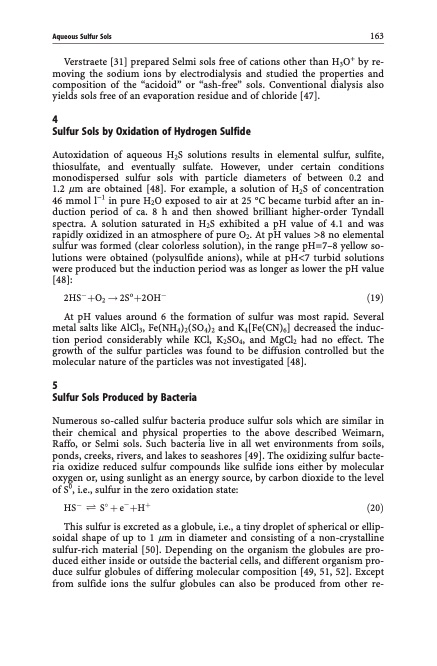
PDF Publication Title:
Text from PDF Page: 173
Aqueous Sulfur Sols 163 Verstraete [31] prepared Selmi sols free of cations other than H3O+ by re- moving the sodium ions by electrodialysis and studied the properties and composition of the “acidoid” or “ash-free” sols. Conventional dialysis also yields sols free of an evaporation residue and of chloride [47]. 4 Sulfur Sols by Oxidation of Hydrogen Sulfide Autoxidation of aqueous H2S solutions results in elemental sulfur, sulfite, thiosulfate, and eventually sulfate. However, under certain conditions monodispersed sulfur sols with particle diameters of between 0.2 and 1.2 mm are obtained [48]. For example, a solution of H2S of concentration 46 mmol l1 in pure H2O exposed to air at 25 C became turbid after an in- duction period of ca. 8 h and then showed brilliant higher-order Tyndall spectra. A solution saturated in H2S exhibited a pH value of 4.1 and was rapidly oxidized in an atmosphere of pure O2. At pH values >8 no elemental sulfur was formed (clear colorless solution), in the range pH=7–8 yellow so- lutions were obtained (polysulfide anions), while at pH<7 turbid solutions were produced but the induction period was as longer as lower the pH value [48]: 2HSþO2 ! 2Soþ2OH ð19Þ At pH values around 6 the formation of sulfur was most rapid. Several metal salts like AlCl3, Fe(NH4)2(SO4)2 and K4[Fe(CN)6] decreased the induc- tion period considerably while KCl, K2SO4, and MgCl2 had no effect. The growth of the sulfur particles was found to be diffusion controlled but the molecular nature of the particles was not investigated [48]. 5 Sulfur Sols Produced by Bacteria Numerous so-called sulfur bacteria produce sulfur sols which are similar in their chemical and physical properties to the above described Weimarn, Raffo, or Selmi sols. Such bacteria live in all wet environments from soils, ponds, creeks, rivers, and lakes to seashores [49]. The oxidizing sulfur bacte- ria oxidize reduced sulfur compounds like sulfide ions either by molecular oxygen or, using sunlight as an energy source, by carbon dioxide to the level of S0, i.e., sulfur in the zero oxidation state: HS ÐSþeþHþ ð20Þ This sulfur is excreted as a globule, i.e., a tiny droplet of spherical or ellip- soidal shape of up to 1 mm in diameter and consisting of a non-crystalline sulfur-rich material [50]. Depending on the organism the globules are pro- duced either inside or outside the bacterial cells, and different organism pro- duce sulfur globules of differing molecular composition [49, 51, 52]. Except from sulfide ions the sulfur globules can also be produced from other re-PDF Image | Topics in Current Chemistry

PDF Search Title:
Topics in Current ChemistryOriginal File Name Searched:
Elemental-Sulfur-und-Sulfur-Rich-Compounds-I.pdfDIY PDF Search: Google It | Yahoo | Bing
Sulfur Deposition on Carbon Nanofibers using Supercritical CO2 Sulfur Deposition on Carbon Nanofibers using Supercritical CO2. Gamma sulfur also known as mother of pearl sulfur and nacreous sulfur... More Info
CO2 Organic Rankine Cycle Experimenter Platform The supercritical CO2 phase change system is both a heat pump and organic rankine cycle which can be used for those purposes and as a supercritical extractor for advanced subcritical and supercritical extraction technology. Uses include producing nanoparticles, precious metal CO2 extraction, lithium battery recycling, and other applications... More Info
| CONTACT TEL: 608-238-6001 Email: greg@infinityturbine.com | RSS | AMP |